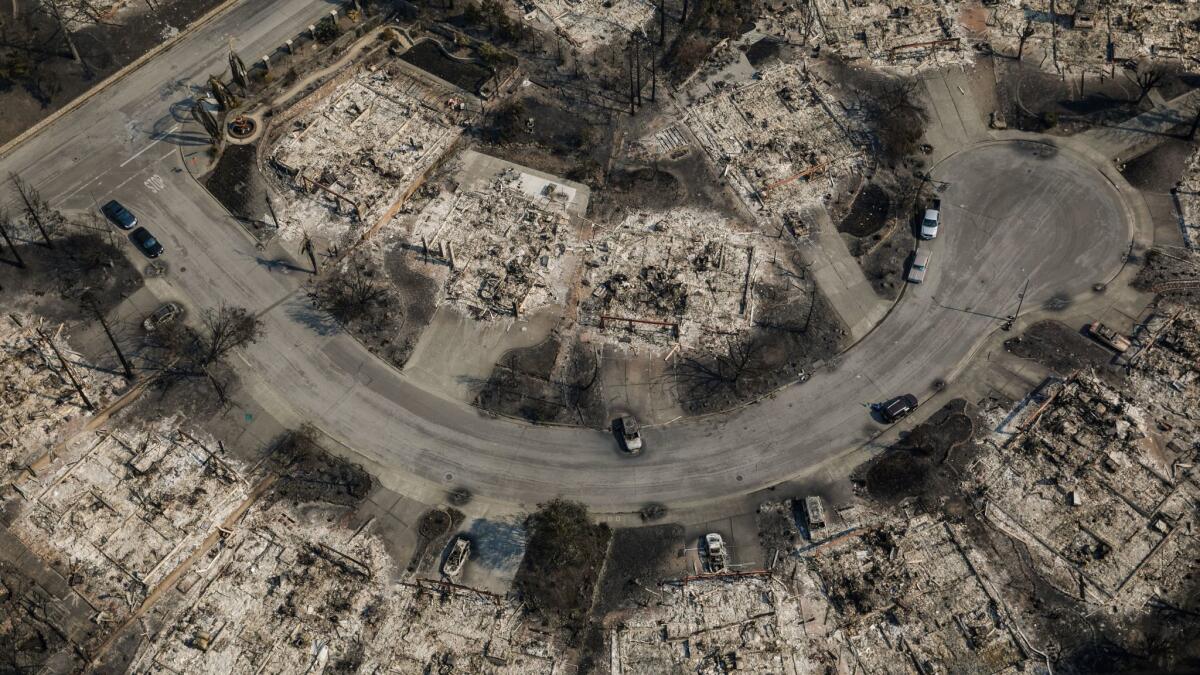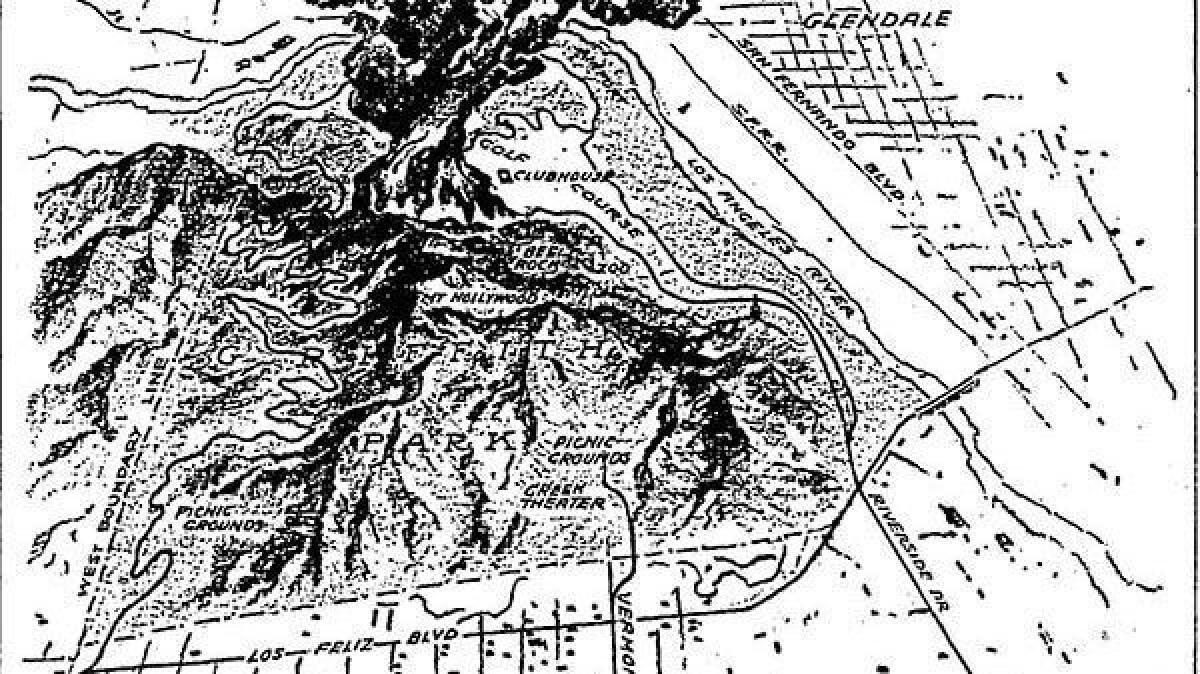California’s deadliest wildfires were decades in the making. ‘We have forgotten what we need to do to prevent it’

- Share via
Historian Stephen Pyne sees no coincidence in the fact that on Oct. 8, 1542 — 475 years to the day before the wildfires began ravaging Northern California — the Spanish explorer Juan Rodríguez Cabrillo saw smoke in the sky above Southern California.
Cabrillo’s pilot, Bartolomé Ferrelo, dutifully recorded the phenomena in the ship’s log, as the explorer christened the San Pedro roadstead “Bahía de los Fumos o Fuegos.”
“Fire isn’t going away,” Pyne says on the phone from his home near Tempe, Ariz.
Pyne, a onetime smoke chaser on the North Rim of the Grand Canyon, is the author of more than 30 books, most on the cultural and social effects of wildland and rural fires around the world. He is completing a 10-volume history of fire in the United States.
“Among the ancient elements,” Pyne writes, “fire is the odd one out. Earth, water, air — all are substances. Fire is a reaction. It synthesizes its surroundings, takes its character from its context. It burns one way in peat, another in tallgrass prairie, and yet another through lodge pole pine.”
And it burns differently still through communities.

‘We’re not seeing something utterly new or alien’
The Northern California fires have not surprised Pyne, and as state and local officials begin to comb through the debris to see how and why this tragedy occurred, he knows that the answers will not be hard to find.
“We’re not seeing something utterly new or alien,” he says, “just a ramping-up of what has gone on for a long time.”
Even though the current fire season has burned less acreage than in 2012 or 2015, it has claimed the highest number of fatalities. This tragedy, as Pyne sees it, is the culmination of nearly a century of failed fire management practices that have been unable to address the increasing escalation — and conflict — between California’s growing population and development, and California’s intrinsic “fire proneness.”
Few fires in California are without precedent. The state’s history is written in fire, each decade marked by losses of life and landscape that follow a cyclical pattern.
In 1919, fires raced through the eastern San Gabriel Mountains burning 115,000 acres, and in 2009, the Station fire claimed 160,000 acres to the west.
The 1956 Inaja fire killed 11 firefighters in the Cleveland National Forest, and the 2003 Cedar fire, following a similar track, killed 15. The 1990 Painted Cave fire in the Santa Ynez Mountains burned 427 homes, and the nearby Jesusita fire claimed 80 in 2009.
Even this year’s Atlas and Nuns fires are not unique, says Jack Cohen, a retired fire research scientist with the U.S. Forest Service, living in Missoula, Mont. Look at the destruction caused by the 2015 Valley fire — 2,000 buildings lost and four fatalities — in Lake County a little farther north.
“It’s a little frustrating when we think these disasters are a first,” Cohen says. “We need to realize that this happened two years ago, 40 miles away, and start thinking about changing our approach and strategy to these fires.”
The case for making this change grows more compelling, especially as catastrophic fire, once the seasonal concern of rural communities, has moved into cities, and the standard explanation — Westerners building homes in the fire-prone regions of the country — no longer applies.
“It’s no longer just the case that we’re building homes where the fires are,” Pyne says. “The fires seem to be going where the houses are.”
Wildland fires entering cities
From Pyne’s perspective, even as the country has become more savvy about wildfire — he credits media attention given to the 1988 fires in Yellowstone and Norman Maclean’s 1992 book “Young Men and Fire” — cities and counties have become less proactive about fire management, and the lack of resources and political will have kept firefighting strategies from evolving.
Cohen agrees. Take the expression “wildland-urban interface,” he says. Used to describe landscapes vulnerable to fire, WUI — as it is known — has outlived its usefulness.
“We have gotten ourselves distracted by the term,” he says. “It no longer matters whether these are cities or rural enclaves. We have tried to classify or categorize these at-risk environments, taking a demographic or geographic approach to the problem, but that is not relevant to the physics of what is actually happening.”
Location, Cohen adds, does not determine the potential for home ignition, and as development has pushed into rural lands over the last 30 years, the distinction between urban fires and wildland fires has grown more fuzzy.
Pyne points to the Tunnel fire in Oakland in 1991 as the first example of how a fire, burning on the fringes of a city, could move into the urban core. “At the time,” he says, “it was considered a freak of geography, but now we’re seeing more of it.”
Urban fires were once common phenomena. History books document the Chicago and San Francisco conflagrations, but more recent fires have left their mark: a 1973 blaze that destroyed a Boston neighborhood and a 1982 blaze that took out four blocks in Anaheim. Subsequent reforms led to the establishment of codes and zoning, insurance requirements and advanced fire protection systems.
Fire codes have kept city residents safe and property intact, but their effectiveness has led to complacency. “Since urban fires no longer happened,” Pyne says, “fires were deemed less a problem.”
As a result, some counties exempt development on the outskirts from regulations that would make homes and buildings fire-resistant. Pyne is reminded of the decision by some parents not to vaccinate their child, believing that vaccinations among other children will keep their child safe.
Such an exemption proved especially catastrophic for residents in the Santa Rosa subdivision of Coffey Park, as The Times reported last week.
“We have forgotten that this could happen, and we have forgotten what we need to do to prevent it,” Pyne says.
As more fires spread into subdivisions, Pyne and Cohen believe the time is right to demand accountability for the firefighting and prevention techniques — urban strategies applied to rural settings and land management overlooked — that agencies have adopted.
Cal Fire, he has written, is essentially “an urban fire service in the woods.”
Before 2006, the agency had been the California Department of Forestry and Fire Protection, which as the name implies, oversaw the state’s wildlands and had a fire prevention mandate. But that mandate, he says, has lapsed as the agency has assumed a more defensive posture, fighting fires when they occur.
This approach, he argues, has been exported around the country. The reasons are varied, but one factor dominates: California’s fires, beginning with the 1961 Bel-Air fire, get national airplay.
“Wildfires in Southern California that shot flames and rained embers on cities were violent, photogenic, and distressingly frequent. They were unavoidable,” Pyne writes. “And California, notably Southern California, became the national center for fire suppression.”
Cohen describes the California model as “the highest level of fire response anywhere in the galaxy,” which would be fine if it worked.
“Yet even at that,” he says, “firefighters are overwhelmed.”
Wildfires as political problem
Last January, Pyne attended a conference organized by the U.S. Forest Service and the National Academy of Sciences. During one session, participants were asked to consider “what scientific research and technological innovation will allow us to get ahead of the problem?”
Fire management, Pyne argues, is not a technological or scientific problem. This is a societal and political problem.
It means counties relocate power lines and clear forested corridors to eliminate that ignition source. “Another, deeper approach,” he adds, “would be to have more local power sources like solar panels.”
It means changing how fires are being managed. Pyne recommends California develop its urban fire services in parity with land management agencies that have experience controlling the state’s combustible wildlands.
It means allowing more controlled burns, and it means applying the same citywide codes and zoning requirements to rural subdivisions.
But Cohen adds, codes won’t keep homes entirely safe. “You can’t code for firewood on decks, pine needles in rain gutters or dead fuel accumulations covered by a green cloak of leaves.”
Fire protection, he says, cannot be the sole responsibility of fire departments. Homeowners and communities must assess “the ignition vulnerability of our houses,” so that the firebrands, blown ahead of the flame front, fail to find flammable materials.
“We must change our perspective and approach to wildland-urban fire disasters by defining wildland-urban fires as a home-ignition problem rather than a problem of wildfire control,” Cohen says. “We don’t have to live in ammo bunkers with steel doors and concrete walls.”
Pyne and Cohen suggest that agencies and officials look less at individual fires and instead at the repeated cycles of destruction. The same landscape burning decades apart is evidence that the current approach to fire prevention has failed.
“If we keep telling the same story — fire as disaster, the firefight as a battlefield — we won’t advance our understanding,” Pyne says.
“We need to change our perspective,” Cohen says. “Wildfires are inevitable, especially under extreme conditions, but the disasters as a result don’t have to be inevitable. We aren’t going to get rid of wildfires, nor do we want to.”
The damage from these fires, he adds, can be limited and contained, and as the 2017 fire season continues to claim more acres and potentially more lives, the motivation should be there.
Three years ago, a strategy for wildland fire was developed by federal fire agencies. But this National Cohesive Wildland Fire Management Strategy has languished, says Pyne, who would like to see California take the lead in implementing its three major recommendations: develop fire-adapted communities (protects cities and exurbs), create fire-resilient landscapes (manage fire in rural landscapes) and increase capabilities to fight fire.
That last one, he adds, gets all the attention. “I get it. It’s good politics. It’s good optics. But it is not solving the fundamentals.”
We can live with fire, Pyne insists. “We need to change how we live.”
Twitter: @tcurwen
ALSO
Southern California prepares for more hot weather and extreme fire danger
California’s deadliest fires set off debate about illegal immigration and sanctuary policies
‘Home away from home’: After fires razed their houses, safari workers find relief in saving animals
More to Read
Sign up for Essential California
The most important California stories and recommendations in your inbox every morning.
You may occasionally receive promotional content from the Los Angeles Times.










